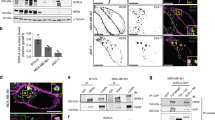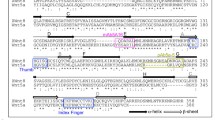Abstract
Since being introduced globally as aspirin in 1899, acetylsalicylic acid has been widely used as an analgesic, anti-inflammation, anti-pyretic, and anti-thrombotic drug for years. Aspirin had been reported to down-regulate surface expression of CD40, CD80, CD86, and MHCII in myeloid dendritic cells (DC), which played essential roles in regulating the immune system. We hypothesized that the down-regulation of these surface membrane proteins is partly due to the ability of aspirin in regulating trafficking/sorting of endocytosed surface membrane proteins. By using an established epidermoid carcinoma cell line (A-431), which overexpresses the epidermal growth factor receptor (EGFR) and transferrin receptor (TfnR), we show that aspirin (1) reduces cell surface expression of EGFR and (2) accumulates endocytosed-EGFR and -TfnR in the early/sorting endosome (ESE). Further elucidation of the mechanism suggests that aspirin enhances recruitment of SNX3 and SNX5 to membranes and consistently, both SNX3 and SNX5 play essential roles in the aspirin-mediated accumulation of endocytosed-TfnR at the ESE. This study sheds light on how aspirin may down-regulate surface expression of EGFR by inhibiting/delaying the exit of endocytosed-EGFR from the ESE and recycling of endocytosed-EGFR back to the cell surface.









Similar content being viewed by others
Abbreviations
- EGFR:
-
Epidermal growth factor receptor
- TfnR:
-
Transferrin receptor
- EE:
-
Early endosome
- ESE:
-
Early/Sorting endosomes
- RE:
-
Recycling endosome
- LE:
-
Late endosome
- SNX:
-
Sorting nexin
- AMC:
-
Aspirin-induced membrane compartment
- NRAMP2:
-
Natural resistance-associated macrophage protein 2
- CysLT1 :
-
Cysteinyl leukotriene receptor
- SR-BI:
-
Scavenger receptor class B type I
References
Wieduwilt MJ, Moasser MM (2008) The epidermal growth factor receptor family: biology driving targeted therapeutics. Cell Mol Life Sci 65:1566–1584
Sorkin A, Goh LK (2009) Endocytosis and intracellular trafficking of ErbBs. Exp Cell Res 315:683–696
Sadowski L, Pilecka I, Miaczynska M (2009) Signaling from endosomes: location makes a difference. Exp Cell Res 315:1601–1609
Lawrence CM, Ray S, Babyonyshev M, Galluser R, Borhani DW, Harrison SC (1999) Crystal structure of the ectodomain of human transferrin receptor. Science 286:779–782
Gruenheid S, Canonne-Hergaux F, Gauthier S, Hackam DJ, Grinstein S, Gros P (1999) The iron transport protein NRAMP2 is an integral membrane glycoprotein that colocalizes with transferrin in recycling endosomes. J Exp Med 189:831–841
Matasic R, Dietz AB, Vuk-Pavlovic S (2000) Cyclooxygenase-independent inhibition of dendritic cell maturation by aspirin. Immunology 101:53–60
Sousa AR, Parikh A, Scadding G, Corrigan CJ, Lee TH (2002) Leukotriene-receptor expression on nasal mucosal inflammatory cells in aspirin-sensitive rhinosinusitis. N Engl J Med 347:1493–1499
Tancevski I, Wehinger A, Schgoer W, Eller P, Cuzzocrea S, Foeger B, Patsch JR, Ritsch A (2006) Aspirin regulates expression and function of scavenger receptor-BI in macrophages: studies in primary human macrophages and in mice. FASEB J 20:1328–1335
Karagiannis TC, Lobachevsky PN, Leung BK, White JM, Martin RF (2006) Receptor-mediated DNA-targeted photoimmunotherapy. Cancer Res 66:10548–10552
Huang D, Cai DT, Chua RY, Kemeny DM, Wong SH (2008) Nitric-oxide synthase 2 interacts with CD74 and inhibits its cleavage by caspase during dendritic cell development. J Biol Chem 283:1713–1722
Ho YH, Cai DT, Huang D, Wang CC, Wong SH (2009) Caspases regulate VAMP-8 expression and phagocytosis in dendritic cells. Biochem Biophys Res Commun 387:371–375
Goding JW, Burns GF (1981) Monoclonal antibody OKT-9 recognizes the receptor for transferrin on human acute lymphocytic leukemia cells. J Immunol 127:1256–1258
Pannecouque C, Daelemans D, De Clercq E (2008) Tetrazolium-based colorimetric assay for the detection of HIV replication inhibitors: revisited 20 years later. Nat Protoc 3:427–434
Ponka P, Lok CN (1999) The transferrin receptor: role in health and disease. Int J Biochem Cell Biol 31:1111–1137
Maxfield FR, McGraw TE (2004) Endocytic recycling. Nat Rev Mol Cell Biol 5:121–132
Le Roy C, Wrana JL (2005) Clathrin- and non-clathrin-mediated endocytic regulation of cell signalling. Nat Rev Mol Cell Biol 6:112–126
Fields IC, Shteyn E, Pypaert M, Proux-Gillardeaux V, Kang RS, Galli T, Folsch H (2007) v-SNARE cellubrevin is required for basolateral sorting of AP-1B-dependent cargo in polarized epithelial cells. J Cell Biol 177:477–488
Patki V, Virbasius J, Lane WS, Toh BH, Shpetner HS, Corvera S (1997) Identification of an early endosomal protein regulated by phosphatidylinositol 3-kinase. Proc Natl Acad Sci USA 94:7326–7330
Wong SH, Xu Y, Zhang T, Hong W (1998) Syntaxin 7, a novel syntaxin member associated with the early endosomal compartment. J Biol Chem 273:275–380
Worby CA, Dixon JE (2002) Sorting out the cellular functions of sorting nexins. Nat Rev Mol Cell Biol 3:919–931
Kurten RC, Cadena DL, Gill GN (1996) Enhanced degradation of EGF receptors by a sorting nexin, SNX1. Science 272:1008–1010
Xu Y, Hortsman H, Seet L, Wong SH, Hong W (2001) SNX3 regulates endosomal function through its PX-domain-mediated interaction with PtdIns(3)P. Nat Cell Biol 3:658–666
Takatsu H, Sakurai M, Shin HW, Murakami K, Nakayama K (1998) Identification and characterization of novel clathrin adaptor-related proteins. J Biol Chem 273:24693–24700
Feng Y, Hu J, Xie D, Qin J, Zhong Y, Li X, Xiao W, Wu J, Tao D, Zhang M, Zhu Y, Song Y, Reed E, Li QQ, Gong J (2005) Subcellular localization of caspase-3 activation correlates with changes in apoptotic morphology in MOLT-4 leukemia cells exposed to X-ray irradiation. Int J Oncol 27:699–704
Kalgutkar AS, Crews BC, Rowlinson SW, Garner C, Seibert K, Marnett LJ (1998) Aspirin-like molecules that covalently inactivate cyclooxygenase-2. Science 280:1268–1270
Liyasova MS, Schopfer LM, Lockridge O (2010) Reaction of human albumin with aspirin in vitro: mass spectrometric identification of acetylated lysines 199, 402, 519, and 545. Biochem Pharmacol 79:784–791
Choudhary C, Kumar C, Gnad F, Nielsen ML, Rehman M, Walther TC, Olsen JV, Mann M (2009) Lysine acetylation targets protein complexes and co-regulates major cellular functions. Science 325:834–840
Chiang N, Serhan CN, Dahlen SE, Drazen JM, Hay DW, Rovati GE, Shimizu T, Yokomizo T, Brink C (2006) The lipoxin receptor ALX: potent ligand-specific and stereoselective actions in vivo. Pharmacol Rev 58:463–487
Claria J, Lee MH, Serhan CN (1996) Aspirin-triggered lipoxins (15-epi-LX) are generated by the human lung adenocarcinoma cell line (A549)-neutrophil interactions and are potent inhibitors of cell proliferation. Mol Med 2:583–596
Piper RC, Katzmann DJ (2007) Biogenesis and function of multivesicular bodies. Ann Rev Cell Dev Biol 23:519–547
Sorkin A, Von Zastrow M (2002) Signal transduction and endocytosis: close encounters of many kinds. Nat Rev Mol Cell Biol 3:600–614
Kim EK, Choi EJ (2010) Pathological roles of MAPK signaling pathways in human diseases. Biochim Biophys Acta 1802:396–405
Ahn S, Kim J, Lucaveche CL, Reedy MC, Luttrell LM, Lefkowitz RJ, Daaka Y (2002) Src-dependent tyrosine phosphorylation regulates dynamin self-assembly and ligand-induced endocytosis of the epidermal growth factor receptor. J Biol Chem 277:26642–26651
Confalonieri S, Salcini AE, Puri C, Tacchetti C, Di Fiore PP (2000) Tyrosine phosphorylation of Eps15 is required for ligand-regulated, but not constitutive, endocytosis. J Cell Biol 150:905–912
Mace G, Miaczynska M, Zerial M, Nebreda AR (2005) Phosphorylation of EEA1 by p38 MAP kinase regulates mu opioid receptor endocytosis. EMBO J 24:3235–3246
Oshima T, Miwa H, Joh T (2008) Aspirin induces gastric epithelial barrier dysfunction by activating p38 MAPK via claudin-7. Am J Physiol Cell Physiol 295:C800–C806
Ou YC, Yang CR, Cheng CL, Raung SL, Hung YY, Chen CJ (2007) Indomethacin induces apoptosis in 786-O renal cell carcinoma cells by activating mitogen-activated protein kinases and AKT. Eur J Pharmacol 563:49–60
Becker JC, Muller-Tidow C, Stolte M, Fujimori T, Tidow N, Ilea AM, Brandts C, Tickenbrock L, Serve H, Berdel WE, Domschke W, Pohle T (2006) Acetylsalicylic acid enhances antiproliferative effects of the EGFR inhibitor gefitinib in the absence of activating mutations in gastric cancer. Int J Oncol 29:615–623
Ordan O, Rotem R, Jaspers I, Flescher E (2003) Stress-responsive JNK mitogen-activated protein kinase mediates aspirin-induced suppression of B16 melanoma cellular proliferation. Br J Pharmacol 138:1156–1162
Jana NR (2008) NSAIDs and apoptosis. Cell Mol Life Sci 65:1295–1301
Elwood PC, Gallagher AM, Duthie GG, Mur LA, Morgan G (2009) Aspirin, salicylates, and cancer. Lancet 373:1301–1309
Rothwell PM, Fowkes FG, Belch JF, Ogawa H, Warlow CP, Meade TW (2011) Effect of daily aspirin on long term risk of death due to cancer: analysis of individual patient data from randomised trials. Lancet 377:31–41
Whitnall M, Howard J, Ponka P, Richardson DR (2006) A class of iron chelators with a wide spectrum of potent antitumor activity that overcomes resistance to chemotherapeutics. Proc Natl Acad Sci USA 103:14901–14906
Acknowledgments
We would like to thank Dr. Boon Chuan Low for reading the manuscript and his valuable comments. This work was supported by research grants from the Academic Research Council-Ministry of Education, Singapore (R182-000-099-112 to S.H.W) and the Singapore National Medical Research Council (R182-000-137-213 to S.H.W).
Author information
Authors and Affiliations
Corresponding author
Electronic supplementary material
Below is the link to the electronic supplementary material.
18_2011_887_MOESM1_ESM.tif
Supplementary material 1 (TIFF 895 kb) Supplementary Fig. 1 The aspirin-mediated accumulation of endocytosed cell surface receptors in the ESE is also regulated by the MAPK pathway. (A) Cell extracts from untreated and aspirin-treated A-431 cells were analyzed by Western-blot analysis using antibodies specific for the phosphorylated forms of p38 MAPK, JNK, and ERK. Results are representative of three independent experiments. (B) Surface antibody-TfnR complexes were allowed to be internalized into cells in the absence or presence of aspirin and p38 inhibitor with concentration and duration as indicated. Image, fluorescence microscope; magnification, 100x; white arrow, the compact structure is the ESE/AMC; red arrow, reduced accumulation of eTfnR in the ESE/AMC in the presence of inhibitors and aspirin. Results are representative of at least two independent experiments. (C) Surface antibody-TfnR complexes were allowed to be internalized into A-431 cells in the presence of 10 mM aspirin for 3 h (a) and followed by treatment with 10 mM aspirin (b, j); normal complete media (f, n); aspirin and p38 inhibitor (c, k); aspirin and ERK inhibitor (d, l); aspirin and JNK inhibitor (e, m); p38 inhibitor (g, o); ERK inhibitor (h, p); and JNK inhibitor (l, q) at indicated time points. Image of fluorescence microscope; magnification, 100x; white arrow, the compact structure is the ESE/AMC; red arrow, reduced accumulation of eTfnR in the ESE/AMC in the presence of inhibitors and aspirin; yellow arrow, reduced accumulation of eTfnR in the ESE/AMC upon removal of aspirin and in the presence of inhibitors; purple arrow, reduced accumulation of eTfnR in the ESE/AMC upon removal of aspirin.
18_2011_887_MOESM2_ESM.tif
Supplementary material 2 (TIFF 61 kb) Supplementary Fig. 2 Aspirin inhibits A-431 cell proliferation. A-431 was treated with indicated concentrations of aspirin for 48 h. Cells were subjected to MTT and the number of viable cells in each sample was normalized to untreated sample. Points, average of normalized values from three independent experiments; bars, ±SD.
Rights and permissions
About this article
Cite this article
Chiow, K.H., Tan, Y., Chua, R.Y. et al. SNX3-dependent regulation of epidermal growth factor receptor (EGFR) trafficking and degradation by aspirin in epidermoid carcinoma (A-431) cells. Cell. Mol. Life Sci. 69, 1505–1521 (2012). https://doi.org/10.1007/s00018-011-0887-z
Received:
Revised:
Accepted:
Published:
Issue Date:
DOI: https://doi.org/10.1007/s00018-011-0887-z




